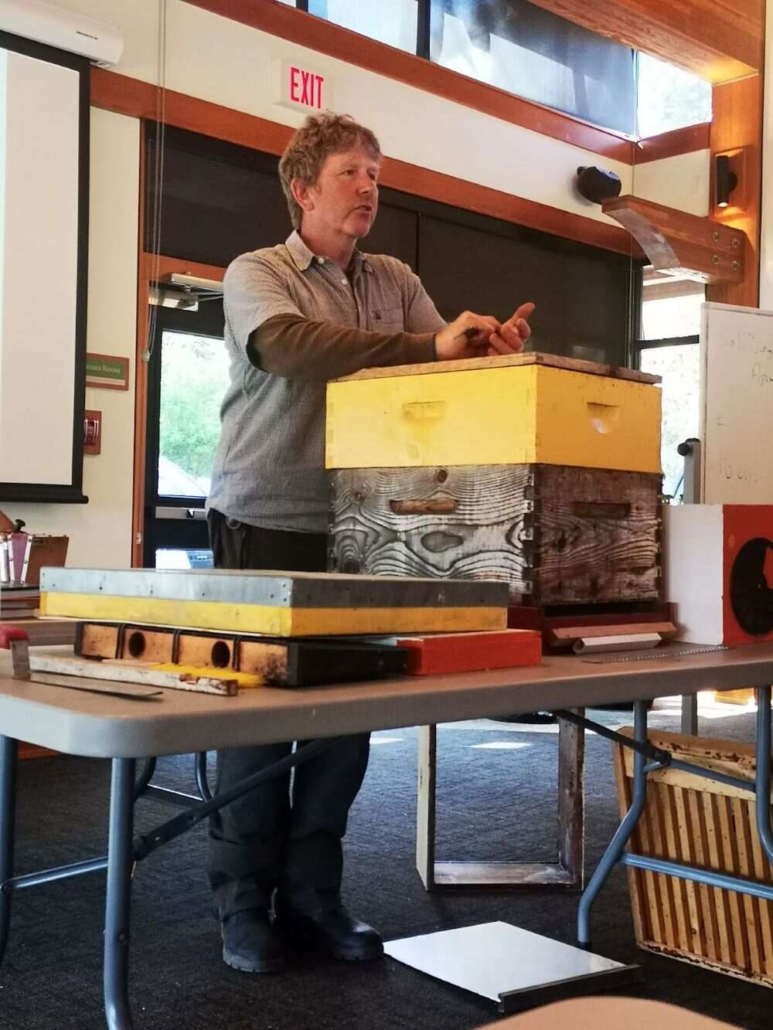Special Topics in Horticulture: Apiculture
Introduction to Apiculture
Student Blog Post by Kai Eversfield & Jill Fraser
On Monday April 11th our class had the opportunity to learn from Gordon MacKay, an experienced beekeeper and horticulturalist. As beekeeping has gained popularity in our region in recent years, it is beneficial to gain some basic skills and knowledge before investing in backyard beekeeping supplies. Getting started in backyard beekeeping is no simple feat and requires a fair amount of research to keep yourself and your bees happy and healthy. Gordon recommended many good books to get us started on our journey (see image for some book covers). Since this class was packed with interesting tips and takeaways, we decided to summarize 4 interesting facts that you might not know about bees!
Propolis - good for bees and humans!
Propolis (also known as bee glue) is a waxy substance produced by bees that is used to build their hives. To make it, bees collect nectar, sap, and other substances from trees like maple, willow, mountain ash, horse chestnut, and poplar. They mix these exudates with beeswax and their saliva, which creates propolis. The propolis they create has many uses within the hive. The bees will use it to seal off cracks in the walls of the hive, and smoothing out rough surfaces within the hive. Propolis also helps to protect the bees from illness, as propolis is antibacterial, antifungal, antiviral and antiparasitic, making it an extremely valuable resource for bees and humans! To help encourage bees to make propolis and prevent diseases from spreading in their hives, beekeepers will use untreated, or damaged wood when building their hives so that the bees will work to seal and smooth out the cracks and ridges, giving them the upper hand against disease.
How do bees produce different flavors of honey?
When you are at the grocery store or farmers market, you might have noticed honey that is labeled with different flavors, such as clover, fireweed, or even maple. This type of honey is called uni-floral or varietal honey, meaning it contains nectar and pollen predominantly from a single type of flower. This is not to be confused with infused honeys, which are produced by directly adding herbs or spices to honey so that it takes on their flavor. Making unifloral honey can be very challenging, since bees can't be confined to a specific area and will travel up to 12km looking for food, so having vast amounts of one flower close by is critical. Another challenging aspect that beekeepers need to be aware of is timing, as most plants will only flower during certain periods of the year. To fix this problem, beekeepers will move their entire hives to different locations throughout the year to take advantage of places that naturally have only a single flower blooming at a time.
The waggle dance - better than Google Maps!
Bees perform a “waggle dance” to give each other directions to flowers, water sources and potential new nest locations. These dances provide details on direction and distance so other bees can find the exact location and don't get lost. During the performance, the direction the bee moves in relation to the sun as well as the duration of the dance are all key factors which hold specific meanings. When a bee is very excited about the location it is describing, it will dance faster to attract more attention from the other bees. If there is more than one bee dancing, it becomes a competition to see who can convince the most bees that their location is superior.
Why do bees swarm?
Swarming is more common than you might think! It is a natural part of the colony's lifecycle, when a new queen is created, the old queen will leave with around 30% of the colony to find a new home elsewhere. They typically swarm in the summer when the abundance of pollen and warm weather make it easier to establish a new home and prepare it for the cold winter. Although bee swarms may look very intimidating, the bees are generally very gentle and slow. This is because they are full of honey as they have been bulking up to prepare for this journey. Bees are typically more aggressive once they have an established hive than they are during a swarm. After leaving their nest, they gather together on a tree branch or any other suitable resting area while forager bees seek out potential new nesting locations. To retrieve a colony that has swarmed, beekeepers will gently push them into a box and bring them back to their apiary.




